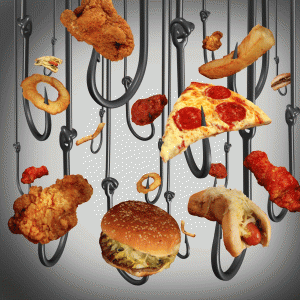CONVENIENCE KILLS!!! SUICIDE BY FOOD
By Dr. Velonda Thompson, Ph.D.
It is no secret that obesity rates have risen in the United States over the past few decades as has the consumption of meals away from home, especially fast food. Food quality and quantity (portion control) are contributing culprits to bulging bellies.
 According to the 2011 CDC study, Fast-Food Consumption and Obesity Among Adults, “The prevalence of obesity increased consistently with frequency of fast-food consumption.” It goes on to say, “The odds of being obese were approximately 50% higher among those consuming fast-food 2 or more times per week compared with those consuming it less than once per week.” Although the study took place in Michigan, the findings were consistent with the national findings of the drastic increase prevalence of obesity in the United States, now considered a major public health concern. Why are we choosing a diet of fast food?
According to the 2011 CDC study, Fast-Food Consumption and Obesity Among Adults, “The prevalence of obesity increased consistently with frequency of fast-food consumption.” It goes on to say, “The odds of being obese were approximately 50% higher among those consuming fast-food 2 or more times per week compared with those consuming it less than once per week.” Although the study took place in Michigan, the findings were consistent with the national findings of the drastic increase prevalence of obesity in the United States, now considered a major public health concern. Why are we choosing a diet of fast food?
The study addressed the reasons for choosing fast food and concluded convenience as the primary reason followed by taste, sociability and lastly cost. Fast food restaurants have embraced the choice for convenience by serving larger, cheaper fast food options and serving it faster. Should fast-food restaurants shoulder the blame when they are providing a service in demand and seeking profits or are we ultimately responsible for the choices we make?
Wisdom dictates that when a person knows better, they will usually do better. We must start to educate ourselves about our food choices and the consequences of those choices. While most people know that fast-food does not have the same nutritional value as meals prepared at home, acknowledging the correlation between a consistent diet of fast-food and obesity must be made. The same CDC study makes the correlation clear in the following statement, “Eating out may lead to over consumption and increase the risk of obesity in part because of larger portion sizes, high energy-dense foods and increased variety and preferred taste of the food. Fast food consumption in particular has been associated with poor diet quality and adverse dietary factors related to obesity, including higher intakes of calories, fat, unsaturated fat and sugar-sweetened drinks.”
The convenience of fast-food and eating out is contributing to obesity.
“Obesity is a risk factor for heart attack and high blood pressure” (Balch, 2010). It is estimated that obesity accounts for 21 percent of health care cost and that translates into $190.2 billion per year or 20.6 percent of national health expenditure. When you think obesity, what comes to mind? Food, food and more food! Yes, Americans are eating more.
Portion sizes are larger than previous decades and Americans are choosing the wrong type (animal-based foods vs. plant-based foods) and amount of food. The average size dinner plate today is 11–12 inches compared to a few decades ago when they measured 7–9 inches.
We can blame the food industry and its demand for profits. We can point to the billions of dollars spent by marketing and advertiser’s, cajoling and enticing us to consume products laden with sugar, salt and fat. We might even point the finger at the U.S. Department of Agriculture’s nutrition guidelines, which has been blamed for “touting foods that will guarantee ill health for millions.” (Forks over Knives, 2011) There are many players that have brought us to the current state of health but we have the power to make better food choices.
Choose to move and make over your plate.





Leave A Comment